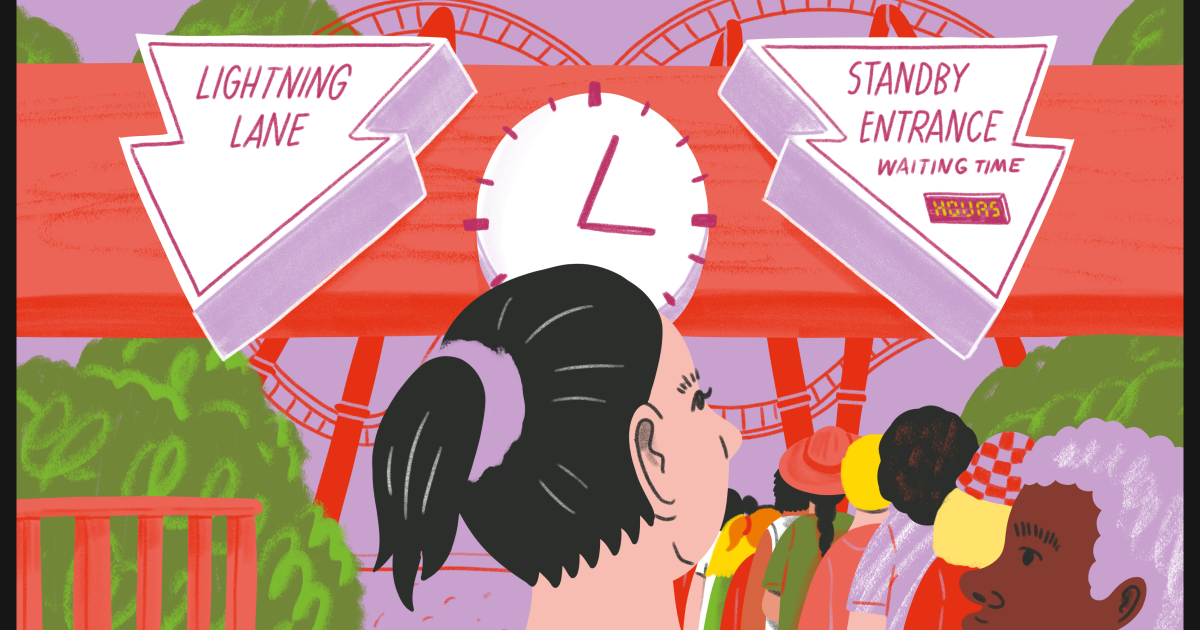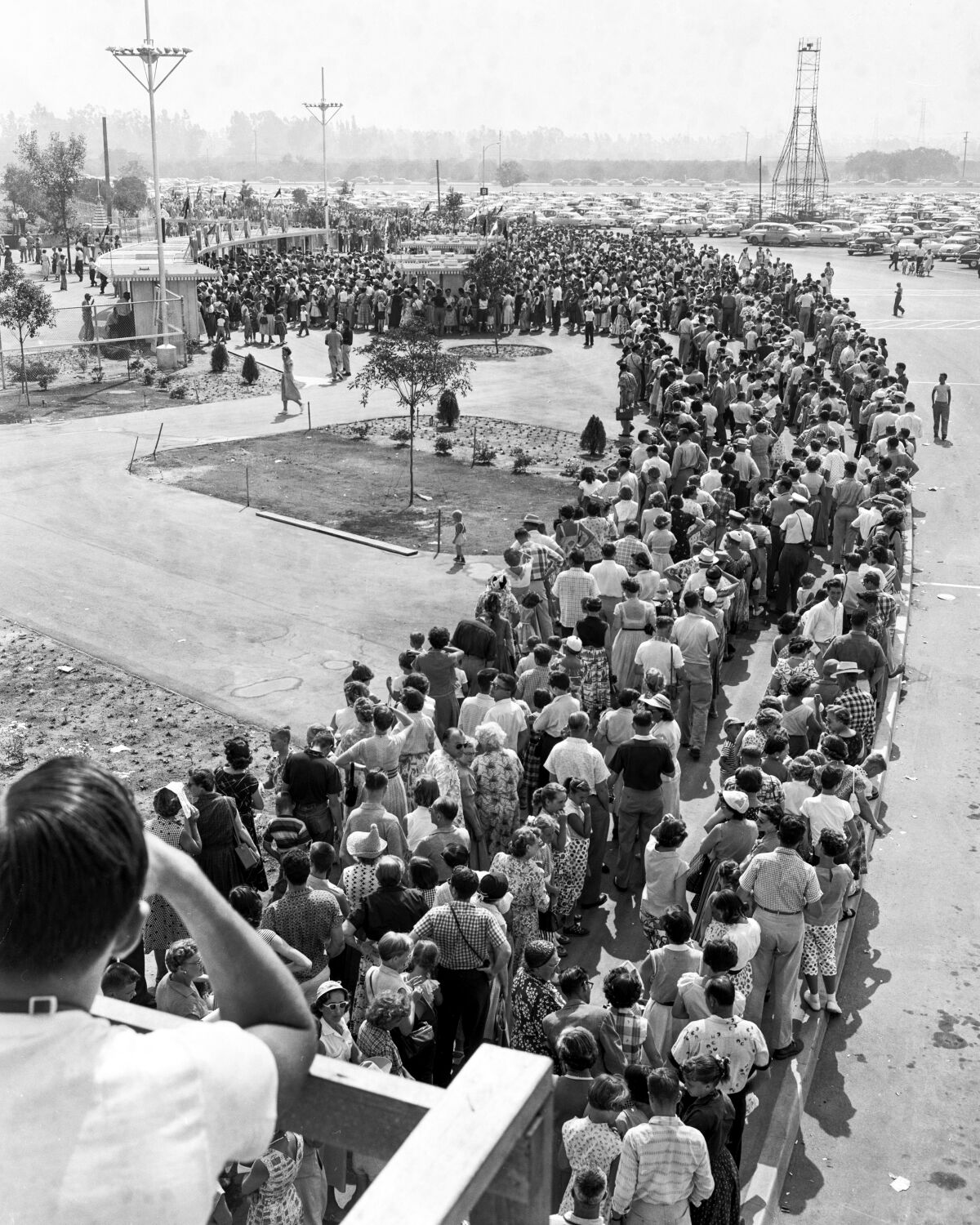Sorry. Here is a cut and paste. Unfortunately, it's missing the photos of the people quoted in the article.
]Disneyland feels classist now. Is it killing the magic for everyone?
“Disneyland is your land.”
Those were Walt Disney’s words to the crowd in his speech on the park’s opening day in 1955. But that didn’t mean he was giving it away — only that the park’s patriarch had ideals for what Disneyland could be. Those ideals have long clashed with Disneyland’s interests as a business enterprise.
Disneyland is a place I visit regularly, typically at least twice per month. Normally it’s a reset, where I return after a particularly stressful day or week. But there have been times on recent trips where a new feeling has crept into my Disneyland experience — the unsettling sense that I could be having more fun if I spent more money.
Prior to Disneyland’s extended, pandemic-forced closure, once you passed the gates, everyone had the opportunity to have more or less the same magical day in Disneyland. But today, that admission fee comes with an asterisk: Arguably, to enjoy your day at the Disneyland Resort you will need to purchase a host of add-ons.
[COLOR=var(--primary-text-color)] [/COLOR]
[/COLOR]
This can get confusing. Tucked in the Disneyland app is [COLOR=var(--primary-body-link-color)]the line-skipping feature Genie+[/COLOR], which typically starts at $25 but on crowded days will hit $30. Genie+ provides access to Lightning Lanes — what was called FastPass and was free in the pre-pandemic days — but some Lightning Lanes now charge an extra fee in addition. At Star Wars: Rise of the Resistance, bypassing the standby line will cost you an extra $20 on most days. To pay an added $50 to get on the rides you want after paying as much as $244 just to walk through the turnstile is exhausting.
Disneyland has never been without special privileges for those who can afford them, such as high-priced VIP tours or the fine-dining 21 Royal experience, where up to 12 guests can split a bill of around $15,000. And then there is the private restaurant and lounge that is Club 33, which costs tens of thousands to join and is tucked in a corner of New Orleans Square. But those have mostly been out-of-the-way accoutrements for the in-the-know, whereas the new microtransactions make a divide part of the everyday Disneyland experience.
Today, this sense of haves versus have-nots is starting to create a caste system that can make everyone feel bad. One doesn’t feel so special when standing still in line just to watch those who shelled out more cash stroll by. And those who do spring for Genie+ can feel an unwelcome sense of privilege — and perhaps get some annoyed stares — as they glide past the masses.
There are other headaches. If one wants some added convenience, as well as the ability to play a scavenger-hunt-like game in [COLOR=var(--primary-body-link-color)]Star Wars: Galaxy’s Edge[/COLOR], there’s Magic Band+ to consider, which, while far from a required add-on, can cost around another $35 to $65 per person. And this is all after paying for parking, which is another $30 — or $50 if you opt for “preferred parking” (tip: Don’t, as it provides little benefit).
Entering Disneyland has become akin to booting up a free-to-play mobile game — you can only get by playing for so long before being reminded that you’re all out of coins. And all those microtransactions can kill the magic. The new system views Disneyland not as a cultural institution but as an extension of, say, Disney+, the streaming service with its own tiers (ads or no ads) that create different levels of access. But what works on our television sets doesn’t translate so well to a physical space.[/COLOR]
[COLOR=var(--primary-text-color)]
[/COLOR]
A long-lost fantasy
[COLOR=var(--primary-text-color)]Walt Disney wanted the park to represent a better, more triumphant version of reality, a place where we don’t just escape into fantasy but also see better versions of ourselves and the world we live in. But divorcing oneself from the frustrations of life beyond the Disneyland berm becomes a more difficult task when one’s experience is dictated so heavily by one’s ability — or inability — to spend
[COLOR=var(--primary-body-link-color)]more than the cost of admission[/COLOR].
Even in the park’s early days, fans accused Uncle Walt of making it too expensive for the common American.
“That’s an old-hat thing,” Disney told journalist Pete Martin of the Saturday Evening Post in 1956 when he asked about Disneyland prices, and as confirmed by the Walt Disney Family Museum, which has a transcript of the interview. At the time, the cost of adult admission to Disneyland would run around $3, or close to $34 today.
[COLOR=var(--primary-text-color)]On July 18, 1955, a crowd of about 15,000 lined up before Disneyland ticket windows opened to the public for the first time. Many had waited throughout the night. This photo was published in the July 19, 1955, Los Angeles Times.
(Los Angeles Times)[/COLOR]
Disney dismissed the charge that Disneyland was too costly, noting that, in addition to security and park upkeep, he had a list of bills other entertainment enterprises didn’t: new attractions for one, and new monkeys on the Jungle Cruise for another (“My monkeys have gone to pot,” Disney said). And, Disney reasoned, Disneyland could be a full 13 hours of entertainment.
“How can they compare Disneyland prices with anything else because there is nothing else like it,” Disney said.
[/COLOR]
Out of touch or just business?
[COLOR=var(--primary-text-color)]But one doesn’t need to go back to the 1950s or even the 1970s and the era of ticket books to note how things have changed. The Disneyland experience post-pandemic is significantly different than it was in 2019, when there was still a free FastPass option.
It’s a business perspective that views Disneyland as a transactional rather than a transformational experience. And it’s debatable if all of this has resulted in a better experience or just one with more marketing opportunities.
Increasingly, every crevice of the park is seen as land for a synergistic tie-in. Take the makeover of a Disney California Adventure dining area into a nod to San Fransokyo from the “Big Hero 6” films and series: It’s an unnecessary spend, remaking a relatively quiet slice of the park into another place for character meet-and-greets and merchandise kiosks.
Genie+, I believe, is increasingly a necessary purchase to have a successful Disneyland day. But it makes going to Disneyland feel pay-to-win. The dangerous slippery slope is the [COLOR=var(--primary-body-link-color)]Individual Lightning Lane[/COLOR], and Disney, thankfully, has used it sparingly, saving it largely for new rides such as Mickey and Minnie’s Runaway Railway and the ever-popular Rise of the Resistance and Radiator Springs Racers. Unfortunately, Genie+ wait times can themselves sometimes stretch upward of 25 minutes, which is only going to have a negative effect on standby wait times.
This hasn’t even touched on other ways Disneyland can nickel-and-dime guests. Sites such as Disney Food Blog, for instance, do a fine job of tracking the relatively consistent price increases on food items, and these days a bottle of water can cost close to $4.50, which seems offensive in a region that’s often sunny and warm. Do yourself a favor and bring a refillable water bottle.
But recent comments by [COLOR=var(--primary-body-link-color)]reinstated CEO Bob Iger[/COLOR] have raised hope among fans that changes could be coming. “I always believed that Disney was a brand that needs to be accessible,” he reportedly told a Morgan Stanley media conference in March. “And I think that in our zeal to grow profits, we may have been a little bit too aggressive about some of our pricing.”
Much of this microtransaction approach occurred during the [COLOR=var(--primary-body-link-color)]brief regime of Bob Chapek[/COLOR], who prior to becoming CEO in 2020 had been leader of the parks division since 2015. And while Chapek’s reign over the parks overlapped with Iger’s earlier tenure, many of the projects launched in the Chapek era telegraph an overall approach to Disney parks that views them as little more than brand deposits. See, for instance, the remake of California Adventure’s Paradise Pier to [COLOR=var(--primary-body-link-color)]Pixar Pier[/COLOR], a theming-on-the-cheap approach that did little more than add a Pixar gloss to what had been elegantly designed as a nod to California history.
The most ambitious project launched in the Chapek era — the[COLOR=var(--primary-body-link-color)] brilliant Galactic Starcruiser at Walt Disney World[/COLOR], commonly known as the “Star Wars” hotel — debuted in 2022 with a cost that is laughably out of touch with essentially all of America, as prices start at around $5,000 for two guests for two nights. All of this combined created the impression, rightly or wrongly, that Chapek viewed the Disney theme parks and their hotels as retail rather than life-altering experiences. Iger’s recent comments imply that he recognizes how fans currently view the brand.[/COLOR]
[COLOR=var(--primary-text-color)]
[/COLOR]
Steps in the right direction
[COLOR=var(--primary-text-color)]Disney deserves credit for making a number of consumer-friendly changes in recent weeks.
Shortly after Iger was reinstalled as CEO, the company announced that it would do away with some pandemic-era restrictions, with one goal being to allow ticket buyers to more easily move between parks. Those with Park-Hopper tickets now can swap locations starting at 11 a.m. Previously, it was 1 p.m., which would lock paying guests out of a portion of the resort until the early afternoon.
The company also said it would include, for now, PhotoPass downloads in all Genie+ purchases. More important, the company announced that it would add close to two months’ worth of days when visitors could pay the lowest price for a single park visit: $104. Thus far, that has resulted in the ability to visit Disneyland at its most approachable price on multiple midweek days in May and June, a change from prior years.
There’s more that can be done. While Genie+ isn’t going anywhere, its price can fluctuate based on crowd level. It’d be nice to end the guessing game and keep Genie+ fixed at a more inviting $20, allowing more guests to partake in line-skipping benefits. Disneyland should also take after Walt Disney World and make hotel parking free for those guests who are spending the night. Currently, it’s an added $35 per day on rooms at its three hotels that can only rarely be had for less than $400 per night.
None of this, of course, is an exact science. As the park’s patriarch said, comparing Disneyland prices to other entertainment offerings is a challenge, as there’s simply “nothing else like it.” And many, including me, are willing to pay for such an experience. But even the most die-hard of fans have a breaking point, and that too is an old-hat thing.
[/COLOR][/COLOR]

 www.latimes.com
www.latimes.com



 [/COLOR]
[/COLOR]
